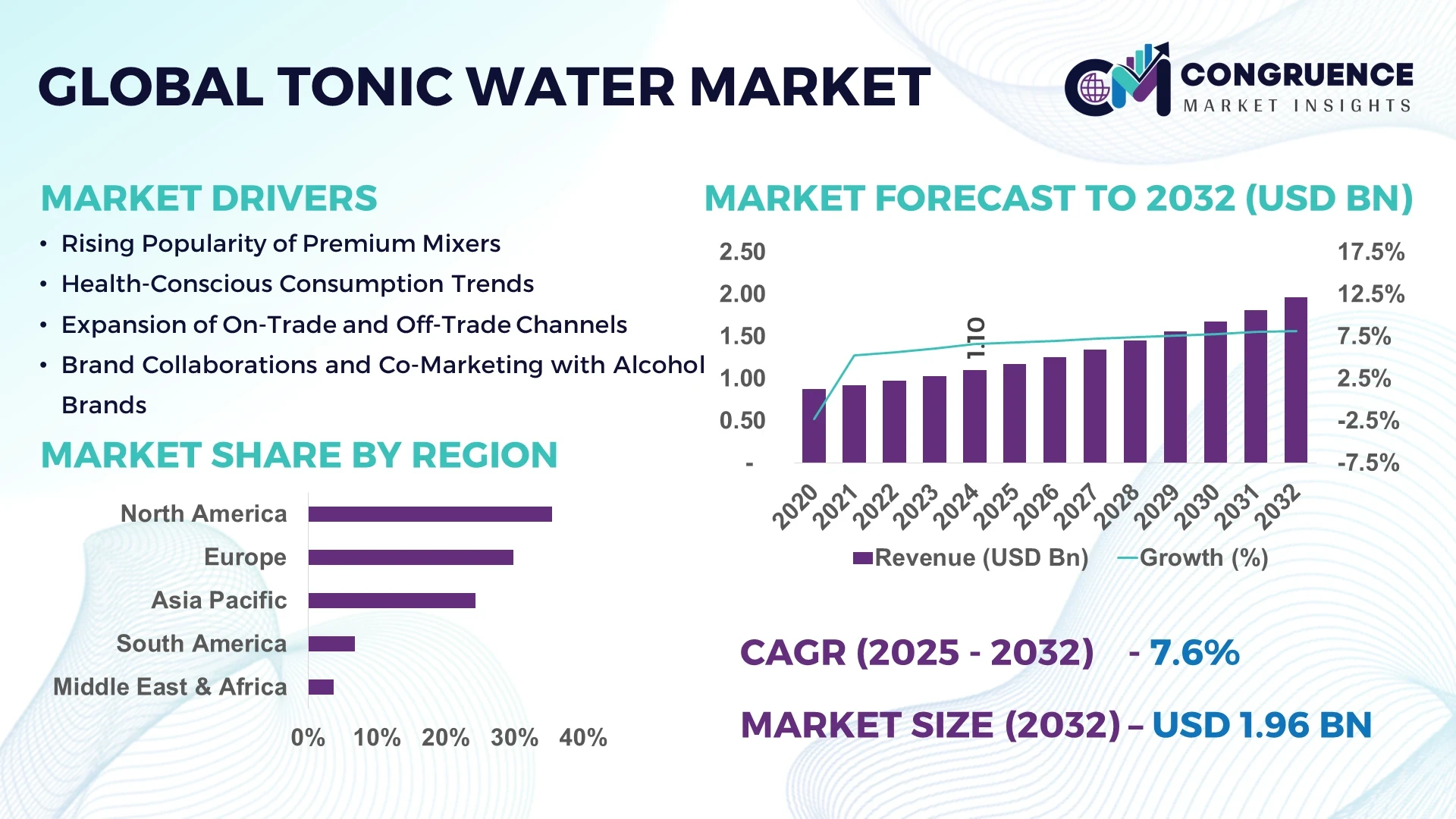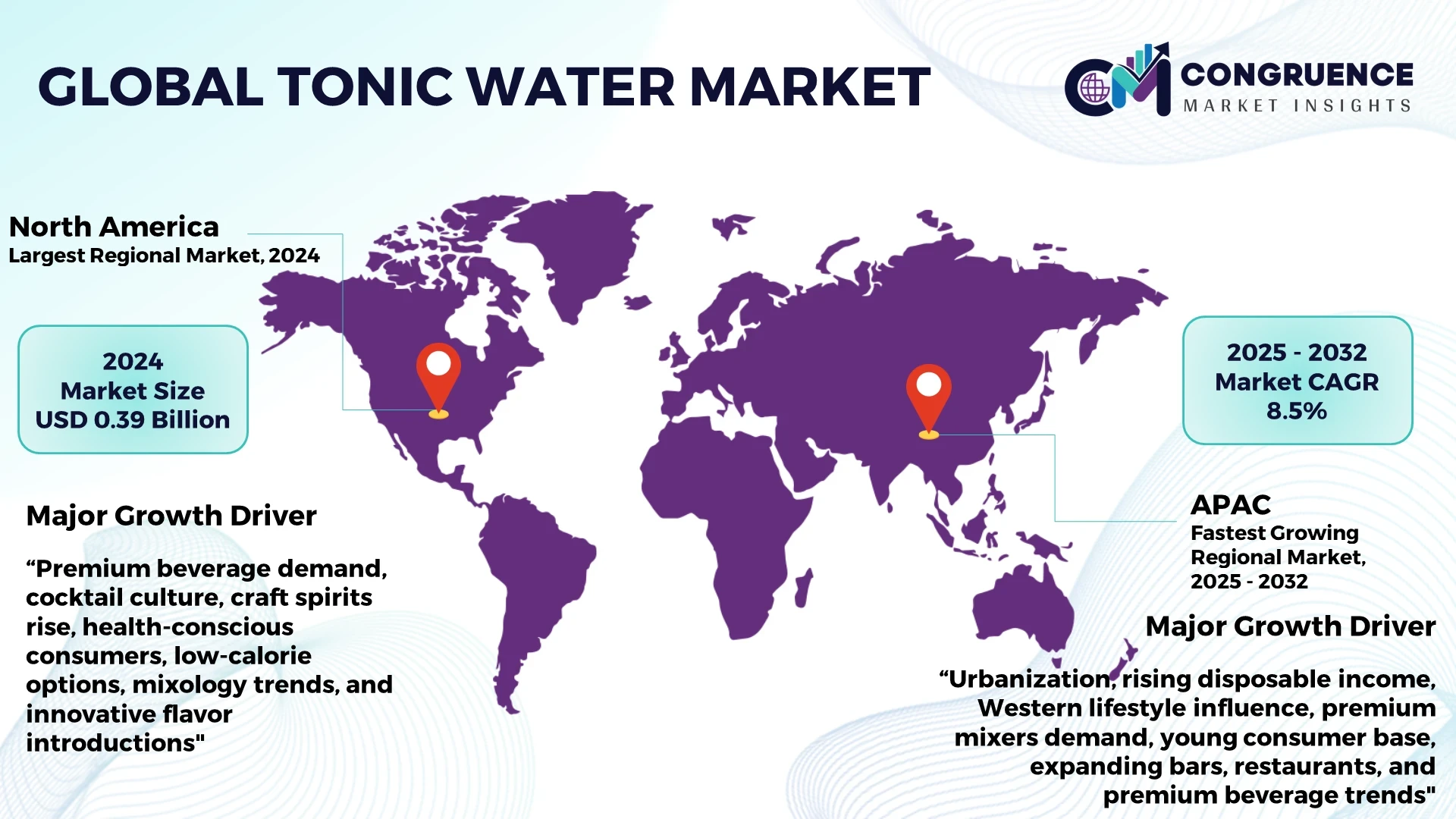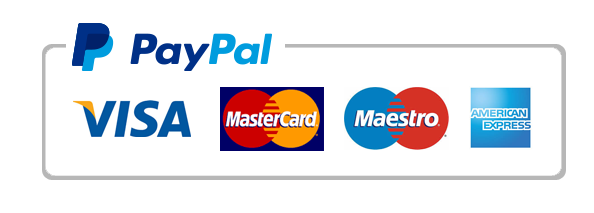Reports
Tonic Water Market Report Overview
The Global Tonic Water Market was valued at USD 1.10 Billion in 2024 and is anticipated to reach a value of USD 1.96 Billion by 2032 expanding at a CAGR of 7.6% between 2025 and 2032. Rising consumer interest in premium and craft beverages, as well as increased demand for low-calorie and flavored mixers, are driving the market's growth. Tonic water, formerly seen as a niche mixer, has grown into a vibrant category, fueled by a thriving cocktail culture, health-conscious customers, and creative product offers.

To Learn More About This Report, Request A Free Sample Copy
Tonic water has evolved from a customary mixer for gin to a popular beverage with its own personality. Tonic water was originally intended for therapeutic purposes due to its quinine component, but it is today enjoyed around the world for its distinct bitter flavor and flexibility. Its natural quinine content, which gives it its signature bitter flavor, is being supplemented with floral and citrus ingredients to appeal to a broader audience. Tonic water is also being utilized in non-alcoholic mocktails and wellness cocktails, broadening its uses beyond classic gin and tonic pairings. The rising hotel business, as well as the availability of tonic water through modern trade channels, are helping to boost market demand, particularly in emerging markets where urbanization and lifestyle changes are impacting consumption habits. The market's expansion reflects a larger trend of premiumization, wellness, and craft beverage consumption.
With consumers increasingly looking for sophisticated and health-conscious beverage options, tonic water has emerged as a popular alternative in both alcoholic and non-alcoholic drink categories. Flavored tonic water types such as citrus, elderflower, and cucumber are gaining popularity among younger consumers and cocktail lovers. The rise of premium tonic water brands, strong positioning in the mixers category, and increased innovation in packaging and marketing all contribute to the market's growth. Advances in food science, enhanced flavor formulation, and the expansion of retail and e-commerce platforms offering artisanal and imported tonic brands are all helping to fuel this evolving market.
How AI is Transforming Tonic Water Market
Artificial intelligence (AI) is transforming the tonic water business by streamlining production, improving marketing efforts, and allowing for data-driven decision-making throughout the value chain. Demand forecasting is one of the primary areas where AI is transforming the industry—using real-time sales data and market trends to project future demand for various tonic water varieties, optimizing inventory and decreasing waste. AI-powered algorithms also assist manufacturers in tailoring marketing campaigns by evaluating consumer behavior, preferences, and purchasing trends across geographies and demographics.
In product creation, AI tools are utilized to examine flavor trends and user input in order to create new tonic water variations with a high market potential. For example, spotting rising preferences for natural sweeteners, botanical infusions, or exotic fruit flavors can result in faster product introductions. AI also helps to automate quality control by using vision systems and machine learning to discover anomalies in bottling, labeling, and carbonation levels.
In digital marketing, AI assists brands in running targeted ad campaigns and optimizing pricing tactics on e-commerce platforms. Furthermore, AI-enabled chatbots boost client engagement and feedback collecting. As the tonic water market gets more competitive, using AI technologies allows businesses to remain nimble, innovative, and sensitive to changing consumer needs.
Tonic Water Market Major Driving Forces
· Rising Popularity of luxury Mixers: The growing consumption of luxury alcoholic beverages, particularly gin, has increased demand for high-quality tonic water as a complimentary mixer. Consumers are increasingly valuing taste, carbonation quality, and natural components while selecting a beverage.
· Health-Conscious Consumption Trends: As people grow more health-conscious, there is a greater demand for low-calorie, sugar-free, and naturally flavored tonic water products. This shift is driving brands to innovate and introduce healthier options.
· Expansion of On-Trade and Off-Trade Channels: The rise of bars, pubs, and fine dining places, combined with enhanced retail and e-commerce distribution, is broadening the reach of tonic water in both developed and emerging nations.
· Brand Collaborations and Co-Marketing with Alcohol Brands: Leading tonic water manufacturers are collaborating with spirits brands to promote ideal pairings, resulting in enhanced visibility, brand equity, and market penetration.
Tonic Water Market Key Opportunities
· Rising Demand in Emerging Economies: Rapid urbanization and a growing middle class in Asia Pacific and Latin America present major opportunities for tonic water businesses to extend their footprint and introduce premium options.
· Flavored and Botanical Infusion Innovations: As consumers seek for unusual and exotic flavors, firms can develop tonic waters infused with botanicals, herbs, and fruits to appeal to adventurous palates.
· Sustainable and Eco-Friendly Packaging: As customers become more environmentally conscious, companies are adopting recyclable cans, glass bottles, and sustainable sourcing, making sustainability a market differentiation.
· Growth in the Non-Alcoholic Beverage Market: As the trend toward mindful drinking rises, tonic water is being positioned as a sophisticated standalone beverage or mocktail ingredient, appealing to the zero-alcohol consumer base.
Tonic Water Market Key Trends
· There is a distinct shift toward premium tonic water options, with brands differentiating themselves through artisanal production processes, high carbonation, and natural ingredients.
· Tonic water is no longer just a cocktail mixer; it's also consumed in standalone formats, with applications ranging from wellness drinks to culinary complements.
· As e-commerce grows, tonic water firms are adopting D2C models, selling subscription boxes, limited-edition varieties, and curated cocktail kits directly to customers.
· Brands are experimenting with region-specific ingredients and flavors to appeal to local tastes while also providing global consumers with new and fascinating flavor profiles.
Region-wise Market Insights
North America accounted for the largest market share at 35.4% in 2024 however, Asia Pacific is expected to register the fastest growth, expanding at a CAGR of 8.5% between 2025 and 2032.

To Learn More About This Report, Request A Free Sample Copy
North America dominated the global tonic water market in 2024. The region's supremacy is due to its mature cocktail culture, high awareness of premium mixers, and a significant presence of top global and local tonic water brands. The United States leads consumption due to the popularity of gin-based drinks and the emergence of wellness beverages. Furthermore, health-conscious tendencies are driving up demand for diet and flavored tonic waters.
· In January 2025, Molson Coors Beverage Co. acquired a minority stake in premium mixer brand Fever-Tree, marking its entry into the upscale mixer segment. The investment supports Molson Coors’ diversification strategy beyond beer and strengthens its position in the growing adult non-alcoholic and cocktail mixer market.
Asia Pacific is expected to develop at the quickest rate, with a CAGR of 8.5% between 2025 and 2032. Rapid urbanization, rising disposable income, and the advent of modern retail formats are all contributing to tonic water's expanding popularity. Countries such as India, China, and Japan are showing a growing interest in Western-style alcoholic and non-alcoholic beverages.
Tonic water continues to expand strongly in Europe, thanks to its deep-rooted gin and tonic culture, particularly in the United Kingdom and Spain. The region also excels at innovation, with luxury and craft tonic brands.
Latin America, the Middle East, and Africa are seeing an increase in demand because to rising alcohol consumption, premiumization, and increased knowledge of non-alcoholic cocktail options.
Recent Developments
· In September 2024, Britvic announced continued investments in sustainability initiatives, emphasizing efforts to reduce environmental impact through packaging innovations and enhanced recycling processes. These investments align with Britvic's commitment to achieving net-zero carbon emissions and promoting a circular economy.
· In September 2023, Britvic Mixers introduced its Indian Tonic Water in 330ml six-pack cans, marking the brand's first foray into this format for retail. Available in both classic and zero-sugar variants across the grocery channel, this launch aims to cater to the growing trend of at-home socializing, as more consumers seek to recreate elevated drinking experiences at home.
· In October 2021, Arctic Blue Beverages introduced Arctic Blue Tonic, a low-sugar, low-calorie tonic water crafted from Finland's pure groundwater. Handmade in small batches in Lappeenranta, it complements Arctic Blue Gin, offering flavors reminiscent of Finnish coniferous forests. The tonic became available in Finnish stores in autumn 2021 and expanded to other European markets in 2022.
Market Competition Landscape
The global tonic water industry is very competitive, with both multinational beverage firms and artisanal brands contending for market dominance. Schweppes, Fever-Tree, and Fentimans dominate the premium and mass-market divisions thanks to strong brand recognition, extensive distribution networks, and continual innovation. Fever-Tree has established itself as a market leader in premium tonics by emphasizing natural ingredients and a wide range of flavor variations. Schweppes, backed by Coca-Cola, uses global distribution and brand legacy to maintain supremacy in the mainstream and value markets. Fentimans sells botanical drinks, which appeal to health-conscious and artisan beverage enthusiasts. Artisanal and emerging companies such as Q Mixers and East Imperial are gaining popularity thanks to mixology collaborations and distinctive positioning. Meanwhile, private-label products from merchants and supermarkets are growing in price-sensitive areas.
The market is clearly moving toward premiumization, flavor variety, and sustainability. Brands are investing in recyclable packaging, natural ingredients, and digital marketing to increase customer loyalty. Strategic agreements with alcohol brands, hotel chains, and bars are becoming more popular, providing greater brand exposure and placement.
Key players in the global tonic water market implement various organic and inorganic strategies to strengthen and improve their market positioning. Prominent players in the market include:
· Fever-Tree
· Schweppes (Coca-Cola Company)
· Fentimans Ltd.
· Q Mixers
· East Imperial
· Thomas Henry
· Britvic PLC
· The London Essence Company
· DRY Soda Co.
· Franklin & Sons Ltd
· Luscombe Drinks
· White Rock Beverages
· Artisan Drinks Co.
· Fitch & Leedes
|
Report Attribute/Metric |
Details |
|
Market Revenue in 2024 |
USD 1.10 Billion |
|
Market Revenue in 2032 |
USD 1.96 Billion |
|
CAGR (2025 – 2032) |
7.6% |
|
Base Year |
2024 |
|
Forecast Period |
2025 – 2032 |
|
Historical Data |
2020 to 2024 |
|
Forecast Unit |
Value (US$ Bn) |
|
Key Report Deliverable |
Revenue Forecast, Growth Trends, Market Dynamics, Segmental Overview, Regional and Country-wise Analysis, Competition Landscape |
|
Segments Covered |
· By Type (Regular Tonic Water, Diet/Low-Calorie Tonic Water, and Flavored Tonic Water) · By Packaging (Bottles and Cans) · By Distribution Channel (Supermarkets/Hypermarkets, Convenience Stores, Online Retail, and Foodservice) · By End-User (Household and Commercial) |
|
Geographies Covered |
North America: U.S., Canada and Mexico Europe: Germany, France, U.K., Italy, Spain, and Rest of Europe Asia Pacific: China, India, Japan, South Korea, Southeast Asia, and Rest of Asia Pacific South America: Brazil, Argentina, and Rest of Latin America Middle East & Africa: GCC Countries, South Africa, and Rest of Middle East & Africa |
|
Key Players Analyzed |
Fever-Tree, Schweppes (Coca-Cola Company), Fentimans Ltd., Q Mixers, East Imperial, Thomas Henry, Britvic PLC, The London Essence Company, DRY Soda Co., Franklin & Sons Ltd, Luscombe Drinks, White Rock Beverages, Artisan Drinks Co., Fitch & Leedes |
|
Customization & Pricing |
Available on Request (10% Customization is Free) |
